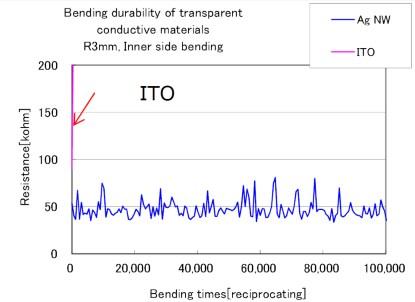



Feature Story
More feature stories by year:
2024
2023
2022
2021
2020
2019
2018
2017
2016
2015
2014
2013
2012
2011
2010
2009
2008
2007
2006
2005
2004
2003
2002
2001
2000
1999
1998
 Return to: 2015 Feature Stories
Return to: 2015 Feature Stories
CLIENT: CAMBRIOS
May 18, 2015: EE Times
In tablets, smartphones, and wearables, silver nanowire film-based transparent conductors can create thinner, lighter, and stronger touchscreens.
Our hands and wrists and other parts of our bodies are not hard or flat or rectangular -- they're soft, pliable, and pressure-sensitive. By comparison, the current batch of personal electronic products we're carrying around are still hard, flat, and pretty rigid. This will change as portable/wearable devices move into mass market acceptance. Flexible electronics circuits are already here, as is system packaging, so why are we still using rigid materials in our display and touch interfaces? The entire wearable device can -- and should -- be flexible to accommodate our biological form.
The differing properties of the two most-applied touchscreen materials, traditional sputtered indium tin oxide (ITO) and silver nanowire conductors, couldn't be more radical.
The most popular touchscreen technology is projected capacitance, or pro-cap. At the core of this technology is a transparent conductor -- a layer of material that needs to conduct electricity while remaining transparent and allowing light from the underlying display to shine through the screen.
Unfortunately, the legacy conductor material, ITO, is neither very conductive nor transparent as compared to silver nanowire. This explains why, in the case of the transparent electrodes used for touchscreen displays -- particularly where screen flexibility and other new properties are required -- there is a massive switch from devices using ITO to ones using silver nanowire.
Let's start with the fact that silver is the most electrically conductive material on Earth. In fact, silver defines conductivity, because all other metals are compared against it. On a scale of 0 to 100, silver ranks 100, with copper at 97 and gold at 76. In tablets, smartphones, and wearables, silver nanowire film-based transparent conductors can create thinner, lighter, and stronger touchscreens. Silver nanowire has a higher transmission that also enhances battery-life-per charge and creates brighter displays since the silver nanowire-based touch sensor does not impede light as greatly as traditional materials.
Creating electronic devices for humans means their interfaces must evolve. Brittle glass and brittle ITO is out. Flexible electronics and interfaces provide enhanced portability and durability, and also open the doors to virtually unlimited design flexibility. Flexible touch displays enable flexible ergonomics. Imagine unbreakable phone screens that flex instead of shattering when dropped. Consider folding a seven-inch tablet so it slips into your pocket.
How about a display that wraps around your arm, or a huge public display wrapping around a pillar or a building in the same way as neon lighting? We are driving toward products like these, and they -- in turn -- are creating increasing demand for flexible, bendable, and rollable touch screens. As more product designers become aware of silver nanowire touch displays, we'll be seeing an extensive array of innovative new products.
If slim industrial design in personal devices is a must, so is flexibility. In real-world tests, silver nanowire-coated films withstand greater than 100,000 turns around a 3mm bending radius, demonstrating great fit in flexible, rollable electronic products. By comparison, ITO does not flex.

Test showing ITO and AgNW bent at 3mm radius (data courtesy of the Nissha Printing Company, Japan).
True single-layer touch sensors based on silver nanowires offer notably lower cost than ITO. This is because they use fewer layers of adhesives and conductors in the touchscreen stack so there's less manufacturing complexity and materials used. "Thin is in" because nearly all products -- particularly portable/wearable ones in the consumer electronics domain -- need to appear sleek and aesthetically attractive. Score another essential advantage for silver nanowire touch sensors.
Overall, silver nanowire-based touchscreens range from slightly less to significantly lower cost than equivalent ITO film-based solutions. This is partially because silver nanowires cost less to pattern using a room temperature laser process. In turn, this enables greater throughput using less energy with quality similar to that achieved with high-end photo processing. Laser patterning is roughly one-fourth the cost of photo patterning because equipment costs are lower. Additionally, the process requires no chemicals/consumables like photo resist, etchants, or strippers. The end result is a greener way of making touchscreens.
The growth potential for flexible electronics is supported by IDTechEx, a market research, technology scouting, and events firm, which reported in part: "...the progress of wearable technology is of increasing interest and focus of developers. It requires the new form factors that printed, organic and flexible electronics can offer for products that can be priced to have reasonable margin".
Silver nanowires are being adopted as the transparent-conductor-of-choice by leading industry heavyweights, including Hitachi, LG, TPK, Nissha, 3M, Okura, and many others. The switch is on, being driven by the range of key factors mentioned above. Fast responding transparent touch screens are essential to the desired user experience. This result can only be achieved with highly transparent conductors that are not visible to the eye. An essential enabler of these important benefits is silver nanowire conductor technology.
Sri Peruvemba is a vice president at Cambrios Technologies Corp. Cambrios provides innovative solutions using nanotechnology. Its ClearOhm silver nanowire-based transparent conductors simplify electronics manufacturing and improve end-product cost and performance for electronic devices.
Return to: 2015 Feature Stories